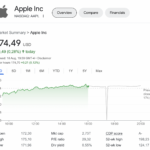Introduction
Microsoft Corporation, founded by Bill Gates and Paul Allen in 1975, is a multinational technology company headquartered in Redmond, Washington. It went public on March 13, 1986, and since then, Microsoft has become one of the most influential and successful companies in the industry. This article aims to provide a comprehensive analysis of Microsoft’s stock performance, examining the factors that have driven its growth, historic performance, and the qualities that have attracted investors over the years.
Historic Performance
Since its initial public offering (IPO), Microsoft’s stock has demonstrated remarkable growth. Initially priced at $21 per share, the stock soared on its first day of trading, closing at $27.75. Since then, the stock has seen several ups and downs but has consistently trended upward. As of September 2021, Microsoft’s stock price has reached over $300 per share, and its market capitalization has surpassed $2 trillion.
Significant milestones in Microsoft’s stock performance include the dot-com bubble in the late 1990s when the stock experienced a surge, reaching its all-time high price of over $58 per share in December 1999. However, during the subsequent market correction, the stock price declined, hitting a low of approximately $20 per share in 2002.
In recent years, Microsoft’s stock has experienced a robust growth trajectory, propelled by the success of its cloud computing business through Azure and its productivity software suites such as Office 365. Over the past decade, Microsoft’s stock has outperformed major market indices, providing exceptional returns for its investors.
Factors Driving Growth
1. Cloud Computing Dominance: Azure, Microsoft’s cloud computing platform, has been a significant driver of the company’s growth. Azure offers a broad range of services, including infrastructure as a service (IaaS), platform as a service (PaaS), and software as a service (SaaS). As organizations increasingly adopt cloud solutions, Azure’s revenue has grown steadily, boosting Microsoft’s overall performance.
2. Office 365 and Productivity Tools: Microsoft’s Office suite has been a staple in businesses and homes for decades. The transition to a subscription-based model with Office 365 has provided a recurring revenue stream, enhancing Microsoft’s financial stability. Additionally, the steady innovation and integration of productivity tools like Teams, SharePoint, and Dynamics 365 have further solidified Microsoft’s position in the market.
3. Artificial Intelligence (AI) and Machine Learning (ML): Microsoft has made significant investments in AI and ML technologies, which are driving innovation across various sectors. The integration of AI capabilities into its products and services has enhanced user experience and efficiency. Azure’s AI capabilities enable developers to build sophisticated applications, attracting customers and generating revenue.
4. Acquisitions and Diversification: Microsoft has strategically acquired companies to expand its product portfolio and market reach. Notable acquisitions include LinkedIn, GitHub, and Minecraft, each contributing to Microsoft’s revenue growth. By diversifying its offerings, Microsoft has mitigated risks associated with industry-specific challenges, resulting in a more resilient business model.
Qualities Attracting Investors
1. Strong Financial Performance: Microsoft consistently delivers solid financial results, with healthy revenue growth and strong profitability. This stability attracts investors seeking a reliable investment opportunity.
2. Dividend and Share Repurchases: Microsoft actively returns value to its shareholders through dividends and share repurchases. Its dividends have consistently increased over time, making Microsoft an appealing choice for income-oriented investors. Furthermore, the company’s share buyback programs have reduced the number of outstanding shares, increasing the value per share for existing shareholders.
3. Innovation and Future Growth Potential: Microsoft’s commitment to innovation and its ability to adapt to changing market dynamics have fueled its growth. Investors are attracted to the company’s forward-looking approach, which includes long-term investments in emerging technologies such as cloud computing, AI, and quantum computing.
4. Leadership and Corporate Culture: Under the leadership of CEO Satya Nadella, Microsoft has undergone a significant cultural transformation, embracing openness and collaboration. This change has revitalized the company, making it more agile and responsive to market demands. Investors value this shift in corporate culture, as it fosters innovation and accelerates growth.
FAQs
1. Is Microsoft a growth stock?
Yes, Microsoft is often considered a growth stock due to its consistent revenue growth, expanding product portfolio, and future growth potential in areas such as cloud computing, AI, and ML.
2. Does Microsoft pay dividends?
Yes, Microsoft pays dividends to its shareholders. The company has a solid track record of increasing its dividends over time, making it an appealing choice for income-oriented investors.
3. What are the risks associated with investing in Microsoft?
While Microsoft has shown resilience and growth, there are always risks associated with any investment. Some potential risks include intense competition in the technology industry, changing market trends, and potential regulatory hurdles.
4. How has Microsoft’s stock performed compared to the overall market?
Microsoft’s stock has consistently outperformed major market indices like the S&P 500 and the NASDAQ. The company’s successful strategic moves, strong financial performance, and market dominance have contributed to its superior stock performance.
Conclusion
Microsoft’s stock performance has been impressive since its IPO, with consistent growth and numerous milestones along the way. The company’s ability to adapt to changing market dynamics, its focus on innovation, and its leadership in emerging technologies have driven its growth. Factors including its dominance in cloud computing, the success of Office 365 and productivity tools, investments in AI and ML, and strategic acquisitions have contributed to its investor appeal.
Investors have been attracted to Microsoft’s strong financial performance, its commitment to returning value to shareholders through dividends and share repurchases, its innovation-driven growth potential, and its transformative corporate culture. While risks exist in any investment, Microsoft’s market dominance and strategic positioning make it one of the most attractive tech stocks available. As technology continues to evolve, Microsoft’s ability to stay ahead of the curve positions it well for sustained growth and long-term success in the stock market.






